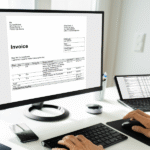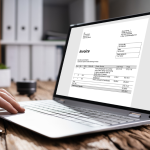In the ever-evolving world of small businesses, effective cash flow management is essential for sustainability and growth. One powerful tool revolutionizing how companies handle their finances is electronic invoicing or e-invoicing. By automating the invoicing process, e-invoicing speeds up payment cycles, reduces late payments, and enhances financial planning and forecasting. In this blog, we’ll explore how e-invoicing can be a game-changer for small businesses.
Ways E-Invoicing Speeds Up Payment Cycles
1. Instant Invoice Delivery
Traditional invoicing methods often involve printing, mailing, and waiting for the recipient to receive and process the invoice. This process can take days or even weeks. E-invoicing eliminates these delays by enabling businesses to send invoices electronically, ensuring immediate delivery. This swift delivery speeds up the entire payment process, as the invoice reaches the client within seconds of being sent.
2. Automated Reminders
Chasing down payments can be time-consuming and uncomfortable. E-invoicing platforms often come with automated reminder features that can be set to notify clients of upcoming due dates and overdue invoices. These reminders help ensure that your invoice stays at the top of your client’s mind, significantly reducing the time it takes to get paid.
3. Simplified Approval Processes
With traditional invoicing, invoices can get lost in paperwork, delaying approval and payment. E-invoicing systems streamline the approval process by allowing invoices to be tracked and approved electronically. This ensures that invoices move swiftly through the approval pipeline, reducing the time for a payment to be authorized and processed.
Reducing Late Payments
1. Enhanced Accuracy
Invoice errors can lead to disputes and payment delays. E-invoicing reduces the likelihood of errors by automating data entry and calculations. This accuracy ensures that clients receive correct invoices, reducing the chances of payment delays caused by invoice discrepancies.
2. Real-Time Tracking
E-invoicing platforms offer real-time tracking capabilities, allowing you to monitor the status of your invoices at any stage. You can see when an invoice has been received, viewed, and approved, giving you greater control and insight into the payment process. This transparency allows you to detect and resolve potential issues before they lead to delays in payments.
3. Improved Client Relationships
Professionalism and efficiency can significantly enhance client relationships. By using e-invoicing, you demonstrate a commitment to modern, efficient business practices. This can foster trust with your clients, increasing the likelihood that they will prioritize timely payment of your invoices. Additionally, the convenience and clarity of e-invoices can lead to better communication and fewer misunderstandings.
Improving Financial Planning and Forecasting
1. Real-Time Financial Data
One of the most significant advantages of e-invoicing is the access to real-time financial data. Traditional invoicing methods often delay data entry and reconciliation, leading to outdated financial information. E-invoicing platforms automatically update your financial records as invoices are sent, received, and paid. This real-time data is invaluable for accurate financial planning and forecasting.
2. Better Cash Flow Management
With e-invoicing, you can predict cash flow more accurately. Knowing when to expect payments allows you to manage your expenses more effectively. You can plan for upcoming costs, allocate resources more efficiently, and make informed decisions about investments and growth opportunities.
3. Detailed Financial Insights
E-invoicing platforms often have robust reporting features that provide detailed insights into your invoicing and payment processes. You can generate reports on payment times, outstanding invoices, and cash flow trends. These insights help you identify patterns and make strategic decisions to improve your financial health.
4. Streamlined Accounting Processes
E-invoicing seamlessly integrates with accounting software, minimizing the time and effort required for manual data entry and reconciliation.This integration guarantees that your financial records remain up-to-date, clearly showing your business’s economic health. Streamlined accounting processes allow you to focus on other critical aspects of your business.
Conclusion
E-invoicing integrates effortlessly with accounting software, reducing the need for manual data entry and reconciliation efforts. By speeding up payment cycles, reducing late payments, and enhancing financial planning and forecasting, e-invoicing helps companies manage their finances more effectively and sustainably. Adopting e-invoicing saves time, reduces administrative burdens, and positions your business as a modern, efficient, and professional operation.
Staying ahead of the curve is essential in today’s competitive business environment. E-invoicing is not just a trend, It’s a strategic step that can give you a competitive edge. If you haven’t yet adopted e-invoicing, now is the perfect opportunity to explore this transformative technology and reap its benefits for your small business.









